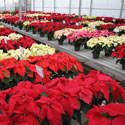Poinsettia Cultivation
Common Name: Poinsettia
Scientific Name: Euphorbia pulcherrima
Family Name: Euphorbiaceae
Tropical evergreen, semi evergreen, or deciduous shrub, leggy to 10 feet or taller. Coarse leaves on upright canes. Inconspicuous flowers, but has showy petal-like bracts in shades of red, white, pink, coral, and purple tones, or combinations of these colors.
In truly tropical areas the plant can be adapted outdoors as a shrub or informal hedge, but in almost all cases is grown as a flowering indoor plant for the winter holiday season.
Height Control
Each week we will look at the growth of eight different poinsettia crops growing in our greenhouses at the University of Florida and make height control decisions. We will provide notes each week on how we made the decisions about growth regulator applications. Plant heights are plotted against a graphical tracking curve that provides a general guide to the desired plant heights at different times during production.
Postharvest
Postharvest, also known as postproduction, deals with how a plant is handled and performs after it leaves a production environment. The postharvest area of study generally ranges from determining at what stage a plant is ready for market to determining proper storage, transport, retail and consumer conditions all with the goal being to maximize crop performance and quality.
Many factors influence the postharvest performance of plants. All segments of production and cultural practices, including genetic influence (cultivar), nutrition, irrigation practices, growing media, and production environment play a major role. Crop quality must be at the highest level when a plant leaves the production facility. Conditions during distribution and retail displays will only maintain plant quality--it will not increase during distribution and retail marketing. Providing proper transport, distribution, and retail conditions is the other vital link in maintaining and promoting postproduction plant quality.
Basics for High Postproduction Quality
- Variety selection can minimize leaf drop and bract edge burn
- Use thick (>8mm) diameter cuttings to avoid lateral stem breakage
- Avoid excessive fertilizer levels
- Use fertilizers with 60-70% NO3-N
- Maintain high light levels
- Avoid warm night temperatures during bract coloration
- Spray bracts weekly with 400ppm calcium from bract color to marketability to avoid bract edge burn
- Transport plants at 53-55 F for 3 days or less
- Display plants 65 to 70F in lighted areas (70-100 f.c.)
Variety Performance
Choosing the right poinsettia variety is often the single most important factor that will influence the performance of poinsettias for the consumer. Through aggressive breeding programs, the new poinsettia varieties have largely overcome traditional postproduction problems like epinasty and leaf drop.
The current postproduction problems associated with some of the newer varieties are bract fading, leaf yellowing, bract edge burn, and bract bruising. Based on these factors, we evaluated more than 40 varieties for their postproduction performance after 30 days indoors. Each variety was rated as excellent, good, or below average.
Click here to view the results (pdf, 11KB)
Growth Regulators
There are several options for growth regulators on poinsettias and the chemicals and rates utilized vary considerably due to climate and grower preferences. In the warmer temperatures of the deep south, we generally use chemical than would be used in cooler regions. In these examples we will use a combination of sprays, early drenches and a late drench to achieve desired heights. Our objectives are to achieve height control with the least possible effect on bract size. More...


